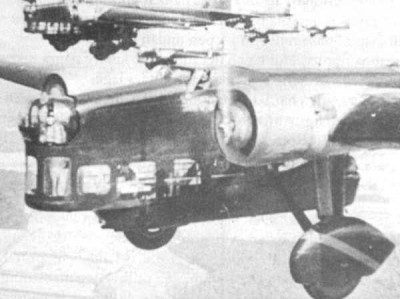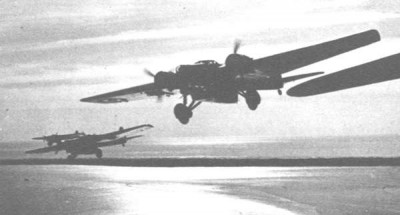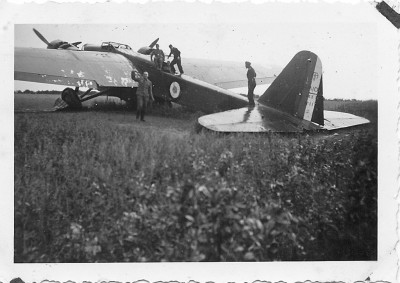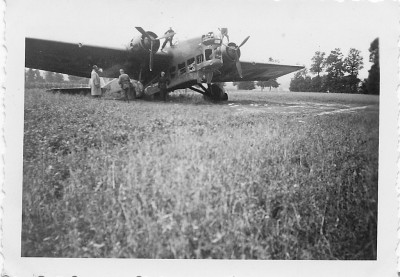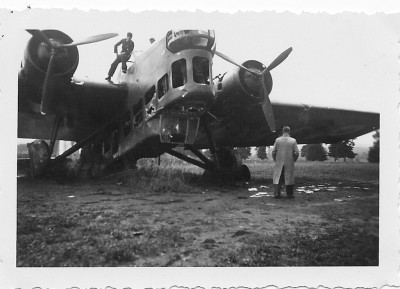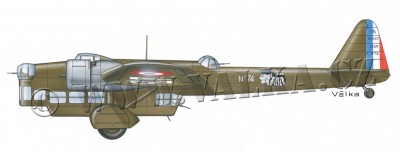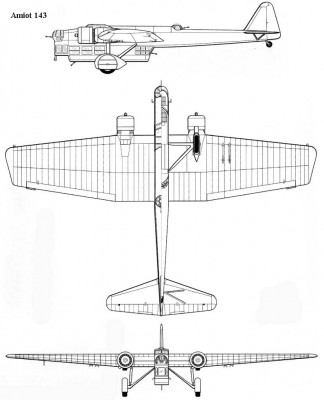| Název: Name: | Amiot 143 M.5 | Amiot 143 M.5 |
| Originální název: Original Name: | Amiot 143 M.5 | |
| Kategorie: Category: | víceúčelový bojový letoun | multi-role combat aeroplane |
| Výrobce: Producer: | DD.MM.1934-DD.03.1937 Société d'emboutissage et de constructions mécaniques, Colombes | |
| Období výroby: Production Period: | DD.MM.1934-DD.03.1937 | |
| Vyrobeno kusů: Number of Produced: | 178 | |
| První vzlet: Maiden Flight: | DD.08.1934 | |
| Osádka: Crew: | 5 | |
| Základní charakteristika: Basic Characteristics: | ||
| Vzlet a přistání: Take-off and Landing: | CTOL - konvenční vzlet a přistání | CTOL - conventional take-off and landing |
| Uspořádání křídla: Arrangement of Wing: | jednoplošník | monoplane |
| Uspořádání letounu: Aircraft Concept: | klasické | conventional |
| Podvozek: Undercarriage: | pevný | fixed |
| Přistávací zařízení: Landing Gear: | kola | wheels |
| Technické údaje: Technical Data: | ||
| Hmotnost prázdného letounu: Empty Weight: | 5455 kg | 12026 lb |
| Vzletová hmotnost: Take-off Weight: | ? kg | ? lb |
| Maximální vzletová hmotnost: Maximum Take-off Weight: | 10360 kg | 22840 lb |
| Rozpětí: Wingspan: | 24,45 m | 80 ft 2 ⅝ in |
| Délka: Length: | 18,24 m | 59 ft 10 ⅛ in |
| Výška: Height: | 5,13 m | 16 ft 10in |
| Plocha křídla: Wing Area: | 100,00 m2 | 1076.39 ft2 |
| Plošné zatížení: Wing Loading: | ? kg/m2 | ? lb/ft2 |
| Pohon: Propulsion: | ||
| Kategorie: Category: | pístový | piston |
| Počet motorů: Number of Engines: | 2 | |
| Typ: Type: | Gnome-Rhône 14Kirs/Kjrs Mistral Major o výkonu 640 kW | Gnome-Rhône 14Kirs/Kjrs Mistral Major, power 858 hp |
| Objem palivových nádrží: Fuel Tank Capacity: | ? | ? |
| Výkony: Performance: | ||
| Maximální rychlost: Maximum Speed: | 310 km/h v 3500 m | 193 mph in 11483 ft |
| Cestovní rychlost: Cruise Speed: | 250 km/h v 1000 m | 155 mph in 3281 ft |
| Rychlost stoupání: Climb Rate: | ? m/s | ? ft/min |
| Čas výstupu na výšku: Time to Climb to: | 14,3 min do 4000 m | 14.3 min to 13123 ft |
| Operační dostup: Service Ceiling: | 7900 m | 25919 ft |
| Dolet: Range: | 1300 km | 808 mi |
| Maximální dolet: Maximum Range: | 2000 km | 1243 mi |
| Výzbroj: Armament: | 1x kulomet MAC 1934 ráže 7,5 mm v přední věži 1x kulomet MAC 1934 ráže 7,5 mm v hřbetní věži 1x kulomet MAC 1934 ráže 7,5 mm v zadním spodním střelišti 1x kulomet MAC 1934 ráže 7,5 mm v zadním předním střelišti 800 kg pum pod křídlem 800 kg pum v pumovnici | 1x 7.5 mm MAC 1934 machine gun in the nose turret 1x 7.5 mm MAC 1934 machine gun in the dorsal turret 1x 7.5 mm MAC 1934 machine gun in the forward gondola 1x 7.5 mm MAC 1934 machine gun in the rear gondola 1760 lb of bombs under the wing 1760 lb of in the bomb bay |
| Uživatelské státy: User States: | | |
| Poznámka: Note: | - | - |
| Zdroje: Sources: | Pelletier, Alain. French Bombers of World War II in Action, No.189. Squadron/Signal Publications, Carrollton 2003. ISBN 0-89747-458-9. Danel, Raymond; Cuny, Jean. L'Aviation Francaise de Bombardement et de Renseignement (1918/1940), Docavia 12. Editiions Lariviere, Paris 1980. Grey, C. G., Brigman, L. Jane´s All the World´s Aircraft 1938. Sampson Low, Marston & Company, London 1938. Němeček, Václav. Amiot 143 M5, L+K 1990/13. www.aviafrance.com | |
Amiot 143 M.5
Amiot 143
Creation
The Amiot 143 was the result of a competition for a multi-seat combat aircraft (Multiplace de Combat) announced by the French Ministry of Aviation in 1928. Four types were entered into the competition, the Amiot 140, the Bleriot 137, the Breguet 410 and the SPCA 30. According to the French (and elsewhere quite widespread) idea at the time, the machines were to be capable of bombing deep into enemy territory, reconnaissance, self-defence against fighters and, as an encore, they were to be able to transport troops (presumably for service in the colonies). Amiot won with his design for the Amiot 140.
The prototype of the Amiot 140 was built in 1931 at the SECM (Societé d'Emboutissage et de Constructions Mécaniques) in Colombes, where Amiot belonged at the time. Trials, including various modifications, stretched until 1934, when an order for production Amiot 143 M5s was signed (the letter M stands for militaire, i.e. military, and unlike the B bomber draws attention to the fact that the type was considered multi-purpose, the number then being the number of crew members). The first aircraft were assembled in April 1935 and production ran until 1938, when the last of the 178 aircraft of this type were completed (some sources list only 138 machines). At the time of the greatest expansion in 1939, they were in the armament of 9 squadrons of the French Air Force.
The crash is a classic example of how the long time from announcement of a competition to production and inclusion can devalue an otherwise quite solid aircraft type. If in 1930 it was a modern all-metal machine it was hopelessly outdated by the end of production in 1938. In late 1939/40 it was converted for transport and training and only the outbreak of war forced the French to deploy it to the front.
Technical details
The aircraft was modern for its time, with covered crew compartments, weapons in gun turrets, all-metal and fitted with powerful engines. Carrying bombs in a covered bomb bay was obviously aerodynamically advantageous, and the ability to carry 6 soldiers (instead of bombs) was a distinct advantage for the colonial power. Initially the crew was smaller (only 4 men), but later the bombardier was relieved of his duties as forward gunner and the crew was increased to 5 men.
From a structural point of view, it was an all-metal monoplane with a fixed undercarriage and a trapezoidal wing. The wing was of three-beam construction and was composed of three parts for ease of manufacture, with engine nacelles woven into the wing at the connection of the outer parts, which in the production machine carried 14-cylinder Gnome-Rhone14Kirs/Kjrs Mistral Major radial engines, the Kirs engine was on the right side, the Kjrs on the left, these engines were counter-rotating so their propellers spun opposite to each other and thus did not produce reaction torque (common in French aircraft at the time). The propellers were metal ground adjustable Gnome-Rhone 1200. The engine installation included tanks stored in the wings and, for machines from number 41 onwards, in the engine nacelles. The motor nacelles were also fitted with a rigid undercarriage with massive wheels covered by aerodynamic cowls. The fuselage had a rectangular cross-section with crew compartments in the front and middle part. The fuselage was lowered behind the crew compartment to provide better shot for the lower machine gun and was finished with conventional tail surfaces. According to some sources, the fuselage was slightly lengthened in front of the tail surfaces from the No. 31.
In the flat fuselage the crew was arranged as follows : in the front on the floor by the sighting window the bombardier, who was also the navigator, above him in the turret the front gunner, in the cockpit behind them the pilot, behind him in the turret on the back of the fuselage the top gunner (both positioned above the bomb bay) and behind the bomb bay the radio operator, who was also the bottom gunner. The aircraft's radios were a long-wave ACP 16 and a short-wave Bronzavia M535. The aircraft originally carried armament consisting of 7.7 mm Lewis machine guns, but were later rearmed with modern 7.5 mm MAC machine guns. Some sources state that a 20 mm cannon was mounted in the front turret, but I have not been able to find it in any photograph and this is probably a mistake. The front turret was of the To 23 type with a 220° range (it could not be fired backwards) and a range of +75° and -50°, the diameter of this turret was 90 cm, the rear turret was of the To 14 bis type, it allowed the weapon to be elevated +110° and -90°, the turret range was 210° and its diameter was 105 cm, the lower firing range was fitted with a To 27 turret with a horizontal range of 200° and a vertical range of 100°.
Overview of versions:
Amiot 140 prototype - two units built
Amiot 142 converted prototype to Hispano-Suiza 12Nbr inline engines one aircraft built
Amiot 143 production version 178 machines built
Amiot 144M machine with converted wing and retractable landing gear one prototype
Amiot 145 machine with Hispano-Suiza 14AA engines remained in the project
Amiot 146 machine with Gnome-Rhone 18 Lars remained in the project
Amiot 147 machine with Hispano-Suiza 12Ydrs/Yfrs engines had twin vertical tail surfaces and was apparently converted to Amiot 150 BE
Amiot 150 BE prototype torpedo and reconnaissance aircraft with float landing gear one prototype, this machine had twin tail surfaces and an enlarged wing.
Alain Pelletier: French bombers of WWII in action, published by Squadron/Signal publications inc., ISBN 0-89747-458-9
https://www.airwar.ru/enc/bww2/a143.html
https://www.answers.com/topic/amiot-143
https://avia.russian.ee/air/france/amiot-143.php
After the Type 143 order was signed, it was anticipated that the Air Force would receive the first machines in the summer of 1934. Unfortunately, delivery was delayed and the first machines were not taken delivery until June 1935. Three machines were received in July, four in August, seven in September, nine in October, six in November and the last ten in December, thus fulfilling the first order for 40 machines. At the same time, SECM received an order for 73 more machines, followed by another for 40, and a final order in December 1936 for 25 machines brought the total to 178. Production then ran with little interruption until March 1938, when the last Amiot 143 was delivered.
The Lewis machine guns used on the first 40 machines were replaced by MACs in December 1936 and Bronzavia M 535 short-wave stations were added. The machines were delivered to units from the late summer of 1935, the first to receive them being GB III at Chartres. This was followed by other bomber and reconnaissance units, so that by 15 December 1936 there were 92 Amiot 143s, 72 with units, 8 with staff squadrons and 12 in reserve. Two machines (serial numbers 45 and 88) were transferred to the "Ministerial Squadron" and given the civilian matriculation F-APIQ and F-AQDZ, under which they were used to transport passengers between France and the colonies. In October, the latter made a 32,000 km crossing Paris-Hanoi-Paris without stops except for refuelling. By 1938, Amiot 143 was hopelessly obsolete (although deliveries ended only in March of that year) and its replacement by other types began, notably the Bloch 131, which was given to 22 Squadron in August, who handed over some of their Amiot to I/38 and II/38 Squadrons. Similarly, 14 Squadron's Amiots were handed over to II/63 Squadron in Morocco, where they replaced Potezy XXV TOE. In the first half of the year, the possibility of reinforcing the French Air Force in Indochina with surplus Amiots was also considered (it was to be 20 machines), but the plan was not implemented. Instead of going to Indochina, the machines from EAA depot 301 were transferred to the school at Cazaux, where they were used for bombing and gunnery training. Also in May, arrangements were made with Poland for five groups of Amiot support to fly over to Poland, one machine was actually there for a few days (it was Amiot 143, with the E 358 matriculation, which flew to Warsaw on 8 August 1939) and would operate from its territory against the Luftwaffe, but at the time of the invasion of Poland the French were unable to respond due to the rapid pace of the war.
Shortly after the start of the war the French had 126 Amiot 143s in service, of which 91 were with the troops (14 non-operational), 29 at the Cazaux school (two non-operational), two at CEAM (i.e. on acceptance) and six under repair. 21 of these machines were at Algiers, the rest at bases in France. The Algiers machines returned and reinforced the air force in October 1939. By mid-October the Amiots had flown 24 day and 20 night reconnaissance sorties (these were mainly 34 Squadron machines). These flights were directed to the Vosges area and especially to the Rhineland. The aircraft also took part in night dropping of leaflets. During this time they lost a single machine shot down by artillery fire on the night of 15-16 October 1939. During this period, GBI/35 exchanged its Amiots for Breguet 691, and handed its Amiots to GBI/38 and GB II/38 as complements, GB I/63 and GBII/63 squadrons at Marrakesh at the same time exchanged its Amiots for Martin 167F, its Amiots were handed over to the Marrakesh flying school.
As of 10 May 1940, when the Germans invaded France, there were still 123 Amiots 143 in the Air Force, but 59 of them were under repair or otherwise out of service. Deliveries of Amiot 354 also began in 1940, but no unit with them (they were given in place of Amiot 143s) was combat capable, so the original machines continued to be used. Interestingly, the French were also producing wooden mock-ups of Amiot 143s and deploying them on airfields as decoy targets, as of 10 May there were 10 on airfields and 30 in production. With the invasion of France there was also a significant increase in losses of Amiot 143s, first five machines were destroyed on 10 May 1940 at the forward airfield at Metz, then on the night of the 10th/11th Amiot 9th and 10th Groupement attacked airfields deep in the Empire. In this and other raids, Amiots 143 dropped a total of 528 tons of bombs. By 13 May the Amiot strength was down to 24 combat-capable aircraft, four each in GB I/34 and GB II/34, seven in GB I/38 and nine in GB II/38.
The most famous raid was carried out on 14 May, when they attacked the heavily defended bridges at Sedan by day, bombing from an altitude of only 800m. Four aircraft were lost and all the others severely damaged. This essentially ended most of the activity of this type in the fighting in France. GBI/34 and GB II/34 units then moved to Bergerac in June 1940 and then flew to Algiers on 16 June 1940. Here they were to be reformed and re-equipped as Bloch 131s. At the time of the Armistice there were 25 Amiot 143s in North Africa, and a further 52 in unoccupied France, the ratio of combat-capable to non-combat-capable machines is unknown. The units flying Amiot 143s were disbanded at Istres on 8 August 1940, the machines being transferred to transport duties. Around 15 Amiots were transferred to Syria as armament for GT 1/15. In October this unit was renamed GT III/15 and transferred to Morocco in early 1942. After the Germans took over the unoccupied part of France, there were still 11 Amiot's in Istres (only 3 were airworthy), their fate with the Luftwaffe is unknown. Operation "Torch" prevented the replacement of Amiot 143 with LeO 451 and the unit was again renamed, this time to GTI I/36, under which designation it participated in the Tunisian campaign, where it performed transport duties. In February 1944, its Amiots were finally scrapped and sent for scrap.
Foreign Service
In some publications one can come across information that several Amiot 143s were sold to Spain, in fact six Amiot 143s were ordered at the beginning of the Civil War but the SECM refused to deliver them to the warring country. Thus, these machines were never flown in Spain.
In the book "KG 200 - The Luftwaffe's most Secret Unit" by Thomas and Ketley, I also came across information that among other machines the 3rd Staffel had 2 (one airworthy) Amiot 143s in its inventory, according to other sources it was even 3 machines used for transport missions.
Among the foreign users, with a bit of exaggeration, one can also include Polish pilots who trained in Caen on Amiot 143 machines.
Alain Pelletier: French bombers of WWII in action published by Squadron/Signal publications inc. ISBN 0-89747-458-9
https://www.airwar.ru/enc/bww2/a143.html
https://www.answers.com/topic/amiot-143
https://avia.russian.ee/air/france/amiot-143.php
This post has not been translated to English yet. Please use the TRANSLATE button above to see machine translation of this post.
| Period | - |
| Producer | - |
| Type | - |
| Camouflage | - |
| Country | - |
| Pilot | - |
| Production No. | - |
| Serial No. / Evidence No. | - |
| Tactical Marking / Imatriculation | - |
| Name | - |
| Unit | - |
| Base | - |
| Date (DD.MM.RRRR) | - |
| Author | - |
| Print size / 300 DPI | - |
| Published with authors permit | - |
| Author Website | - |
| Period | - |
| Producer | - |
| Type | - |
| Camouflage | - |
| Country | - |
| Pilot | - |
| Production No. | - |
| Serial No. / Evidence No. | - |
| Tactical Marking / Imatriculation | - |
| Name | - |
| Unit | - |
| Base | - |
| Date (DD.MM.RRRR) | - |
| Author | - |
| Print size / 300 DPI | - |
| Published with authors permit | - |
| Author Website | - |
This post has not been translated to English yet. Please use the TRANSLATE button above to see machine translation of this post.
Zdroj:
http://ebay.de/
| Period | - |
| Producer | - |
| Type | - |
| Camouflage | - |
| Country | - |
| Pilot | - |
| Production No. | - |
| Serial No. / Evidence No. | - |
| Tactical Marking / Imatriculation | - |
| Name | - |
| Unit | - |
| Base | - |
| Date (DD.MM.RRRR) | - |
| Author | - |
| Print size / 300 DPI | - |
| Published with authors permit | - |
| Author Website | - |
http://ebay.de/
320275636112
| Period | - |
| Producer | - |
| Type | - |
| Camouflage | - |
| Country | - |
| Pilot | - |
| Production No. | - |
| Serial No. / Evidence No. | - |
| Tactical Marking / Imatriculation | - |
| Name | - |
| Unit | - |
| Base | - |
| Date (DD.MM.RRRR) | - |
| Author | - |
| Print size / 300 DPI | - |
| Published with authors permit | - |
| Author Website | - |
http://ebay.de/
320275635589
| Period | - |
| Producer | - |
| Type | - |
| Camouflage | - |
| Country | - |
| Pilot | - |
| Production No. | - |
| Serial No. / Evidence No. | - |
| Tactical Marking / Imatriculation | - |
| Name | - |
| Unit | - |
| Base | - |
| Date (DD.MM.RRRR) | - |
| Author | - |
| Print size / 300 DPI | - |
| Published with authors permit | - |
| Author Website | - |
http://ebay.de/
320275635215
| Period | World War Two [1939-1945] |
| Producer | Amiot |
| Type | Amiot 143 M.5 |
| Camouflage | Standardní vojenská |
 Olivově zelená / Olive Green Olivově zelená / Olive Green Kov, stříbrná / Metalic, silver Kov, stříbrná / Metalic, silver |
|
| Country |  |
| Pilot | - |
| Production No. | - |
| Serial No. / Evidence No. | - |
| Tactical Marking / Imatriculation | 74 |
| Name | - |
| Unit | Bombardovací skupina I/22 [1932-1942] |
| Base | - |
| Date (DD.MM.RRRR) | DD.MM.RRRR |
| Author | Zbyněk Válka |
| Print size / 300 DPI | A4 |
| Published with authors permit | Published with authors permit |
| Author Website | - |
Published with authors permit
This post has not been translated to English yet. Please use the TRANSLATE button above to see machine translation of this post.
| Period | - |
| Producer | - |
| Type | - |
| Camouflage | - |
| Country | - |
| Pilot | - |
| Production No. | - |
| Serial No. / Evidence No. | - |
| Tactical Marking / Imatriculation | - |
| Name | - |
| Unit | - |
| Base | - |
| Date (DD.MM.RRRR) | - |
| Author | - |
| Print size / 300 DPI | - |
| Published with authors permit | - |
| Author Website | - |
Aviacia France vo vtoroj mirovoj vojne, Virtualnyj pilot no. 8/9, str. 41 (Авиация Франции во второй мировой войне, Виртуальный пилот № 8/9)
.| Period | - |
| Producer | - |
| Type | Amiot 143 M.5 |
| Camouflage | - |
| Country | - |
| Pilot | - |
| Production No. | - |
| Serial No. / Evidence No. | - |
| Tactical Marking / Imatriculation | - |
| Name | - |
| Unit | - |
| Base | - |
| Date (DD.MM.RRRR) | DD.MM.RRRR |
| Author | - |
| Print size / 300 DPI | - |
| Published with authors permit | - |
| Author Website | - |
Join us
We believe that there are people with different interests and experiences who could contribute their knowledge and ideas. If you love military history and have experience in historical research, writing articles, editing text, moderating, creating images, graphics or videos, or simply have a desire to contribute to our unique system, you can join us and help us create content that will be interesting and beneficial to other readers.
Find out more